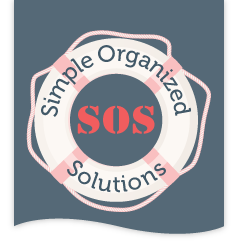 Organizing is not just about putting like with like, purging and labeling containers. Sure, those are important pieces to the process, but that’s not the whole enchilada. Before you start the process, you need to understand both the mental and physical capabilities of the person that needs the organizing solutions.
Organizing is not just about putting like with like, purging and labeling containers. Sure, those are important pieces to the process, but that’s not the whole enchilada. Before you start the process, you need to understand both the mental and physical capabilities of the person that needs the organizing solutions.
Our senior population has a myriad of considerations to address when you organize for them. The first thing to consider is their living environment. If they live alone, do they have homecare workers that visit on a regular basis, and if so, will you need to organize for the senior or the homecare worker, or both?
This subject is near and dear to my heart, because I have an elderly aunt that is blind, and I am her primary caregiver. She knows every inch of her house, so the decision for her to age in place was a no brainer. Since I don’t live with her, and her physical capabilities are limited, we engaged the help of a homecare company. Fortunately, my uncle that passed away several years ago was a veteran, and my aunt receives a VA benefit called Aid & Attendance. This benefit provides the funds to pay for the help my aunt needs to remain living in her home.
The strategies and tips shown below were used when I organized my aunt’s home for her and for her homecare worker. They are not all-inclusive but my hope is that it provides a basis to help you organize spaces for your elder family members and friends. The key is to understand their capabilities so you can create solutions to work specifically for them. If you have other strategies and tips not shown here, I would love it if you would share them here.
• Keep things in the places that the person already has established, if possible: This is really important for people that are blind, because they have pretty good memories, at least my aunt does.
• Keep like things together based on what makes sense to the person: This is actually something to do for everyone. If the thing’s home doesn’t make sense to the person looking for it, they won’t be able to find it again.
• Label everything & use a large font: My aunt’s homecare worker wears reading glasses so this works better for her. Now she can see the labels without her glasses, so she can put everything back where it belongs. My aunt doesn’t read Braille. Touch is a great tool for people that are blind. My aunt used to be a secretary so she types very well, and knows how the keypad is set up on a phone. Because of this, I use bump dots for electronics such as the keypad on her phone, and for the flush keypads on her dishwasher and her microwave, and her washer & dryer. Bump dots are adhesive dots to guide the blind so they can operate electronics in their homes.
• Keep things within reach, especially if the person has physical limitations: My aunt cannot reach the second shelf of her kitchen cabinets, which is where she keeps canned goods. Because of this limitation, I put bins on the counter and labeled them according to the contents. Labeling the bins helps the homecare worker understand where to put away the groceries. Grab it tools work well for those out of reach items too. Another option is a pull down spice rack for smaller items like spices, or even medicine bottles.
• Keep items purged to accommodate the available storage space: My aunt had so many clothes that were stuffed into drawers, that the homecare worker started piling them on top of the dresser because there was no place to put clean clothes. We purged the excess – I described every piece to my aunt so she could make the decisions to donate, or keep. The keepers were organized in the drawers that my aunt chose, and I labeled the drawers with laminate luggage tags in a big font, so I didn’t have to stick adhesive labels on the wooden dresser. The bigger font made it easier for the homecare worker so she didn’t have to put on her reading glasses.
• Expired food products: Not so fresh food products will smell bad, and bread will feel stale to the touch. However, you don’t want them to get to that point before they need to be discarded. Cans, and boxes, are especially problematic for the elderly, and if the person is blind, it really can be a problem. So many times I would open my aunt’s refrigerator and the smell would almost knock me off my feet! To help with this issue, I created a process for grocery shopping for the homecare worker, and posted it on the refrigerator door. It lists all the steps required, starting with making a list and checking for duplicates and expired food products.


